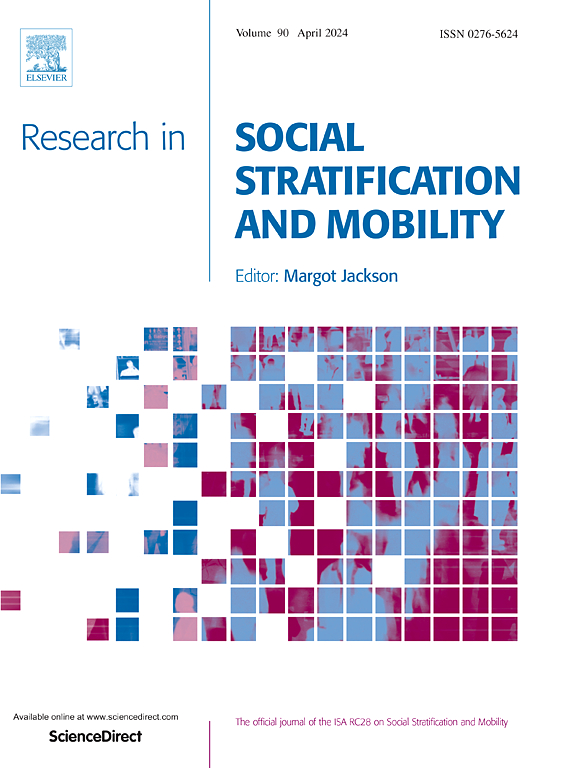Family formation and occupational status: Premium or penalties for women?
IF 2.7
1区 社会学
Q1 SOCIOLOGY
引用次数: 0
Abstract
This paper evaluates the effect of family formation on women’s occupational status, which identifies their social mobility. This study extends research by studying the long-term impact of marriage and the anticipation effect before marriage. We estimate fixed-effects and fixed-effects individual slopes panel models to identify the impact of marriage and childbearing on occupational status using retrospective data from Egypt’s Labor Market Panel Survey for 2018. After accounting for selection based on levels and growth of occupational status, this study found that women witness a marriage premium only in years 4 and 7 after marriage, contrary to the fixed-effects estimates. This result shows that the premium witnessed by married women in the other years is due to selection into marriage based on both status levels and growth. Hence, accounting for various type of selection and estimating a yearly heterogeneous impact of marriage are crucial in estimating the marriage premium. Two possible mechanisms that might result in changes in occupational status are examined. Changes in work experience or employment sector explain the occupational adjustment that happens during the years of marriage, which demonstrates the importance of building women’s human capital and the role of providing public sector jobs that facilitates women’s double-shift roles. The results do not point to an effect of child-birth parities on the occupational status, but rather a marriage premium.
家庭形成与职业地位:对女性有利还是不利?
本文评估了家庭形成对女性职业地位的影响,而职业地位决定了女性的社会流动性。本研究通过研究婚姻的长期影响和婚前预期效应来扩展研究。我们使用2018年埃及劳动力市场面板调查的回顾性数据,估计固定效应和固定效应个体斜坡面板模型,以确定婚姻和生育对职业状况的影响。在考虑了基于职业地位水平和增长的选择之后,本研究发现,女性只在婚后第4年和第7年才会看到婚姻溢价,这与固定效应的估计相反。这一结果表明,已婚女性在其他年份的溢价是由于基于地位水平和成长的选择而进入婚姻。因此,在估计婚姻溢价时,考虑各种类型的选择和估计婚姻的年度异质性影响是至关重要的。研究了可能导致职业地位变化的两种可能机制。工作经验或就业部门的变化解释了婚姻期间发生的职业调整,这表明建立妇女人力资本的重要性和提供公共部门工作的作用,促进了妇女的双重角色。研究结果并没有指出生育对职业地位的影响,而是指出了婚姻溢价。
本文章由计算机程序翻译,如有差异,请以英文原文为准。
求助全文
约1分钟内获得全文
求助全文
来源期刊
CiteScore
7.80
自引率
6.00%
发文量
46
期刊介绍:
The study of social inequality is and has been one of the central preoccupations of social scientists. Research in Social Stratification and Mobility is dedicated to publishing the highest, most innovative research on issues of social inequality from a broad diversity of theoretical and methodological perspectives. The journal is also dedicated to cutting edge summaries of prior research and fruitful exchanges that will stimulate future research on issues of social inequality. The study of social inequality is and has been one of the central preoccupations of social scientists.

 求助内容:
求助内容: 应助结果提醒方式:
应助结果提醒方式:


